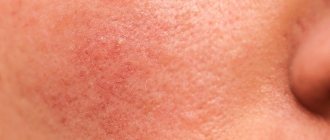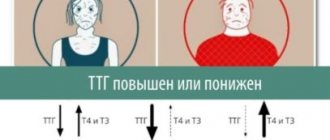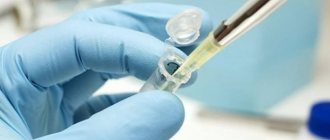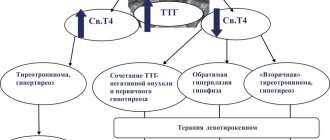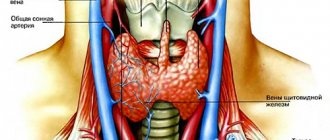Quick Transition Treatment of Thyroid Cancer
Thyroid cancer is a malignant tumor that occurs in the cells of the thyroid gland.
The gland has two lobes, left and right, the lobes are connected by an isthmus, sometimes an additional lobe extends upward from the isthmus - pyramidal. The gland is located in the lower third of the neck, along the front surface, the shape of the gland resembles a butterfly.
The thyroid gland produces hormones that regulate many vital functions: metabolism, heart rate, blood pressure, body temperature.
Until 1990, thyroid cancer was a relatively rare cancer. Since the early 1990s, there has been a steady increase in incidence in all age groups. Since 1992, a connection has been established between the increase in the incidence of thyroid cancer in residents of the southern regions of Belarus and adjacent regions of the Russian Federation with radiation contamination of these territories - primarily with radioactive iodine, after the disaster at the Chernobyl nuclear power plant.
The increase in incidence in recent decades is also associated with the emergence of new, previously unavailable technologies that make it possible to detect small tumor formations in the thyroid gland.
When should you see a doctor?
If you have any of the symptoms described above, and the complaints persist for more than 2 weeks, you should consult a specialist. Thyroid cancer is not the most common disease, so your doctor may need to look into other causes of your complaints.
At the Rassvet clinic, highly professional specialists (oncologist, endocrinologist, therapist) work in one well-coordinated team, this allows us to make a diagnosis and begin treatment as soon as possible, while avoiding unnecessary examinations.
Prevention
Many people who get the disease do not have any risk factors, so it is not known how to prevent thyroid cancer.
Since exposure to radiation in childhood increases the risks, you need to be very careful about any methods of radiation diagnostics and therapy in children, and use them only when clearly necessary. Every person's diet should contain a sufficient amount of iodine.
If a person is diagnosed with medullary cancer associated with a genetic mutation, his relatives need to visit a geneticist and get tested. And in general, if one of your close relatives has been diagnosed with cancer, you need to pay more attention to your health, ask your doctor what types of screening and at what intervals you should undergo.
Causes of thyroid cancer
What exactly causes thyroid cancer is not yet known. Cancer occurs when thyroid cells undergo genetic changes (mutations). Mutations allow cells to grow and multiply quickly and become cancerous. Accumulating atypical (malignant) cells form a thyroid tumor. These malignant cells can then invade nearby tissues and spread throughout the body. This is called metastasis.
There are sporadic thyroid cancer (arising due to some internal reasons) and radiation-induced cancer, resulting from exposure to radiation, primarily the radioactive isotope of iodine. Examples of radiation-induced cancer include the increase in the incidence of thyroid cancer in areas affected by the Chernobyl nuclear power plant accident and in Japan after the atomic bombings of Hiroshima and Nagasaki. Radiation-induced cancer differs from sporadic cancer by a more aggressive course and a higher frequency of metastasis.
Types of thyroid cancer
Treatment tactics and prognosis for future life depend on the type of thyroid cancer. The following types of thyroid cancer are distinguished:
- Papillary thyroid cancer . _ The most common form, accounting for about 80-85% of all malignant thyroid tumors. This tumor arises from follicular cells that produce and store thyroid hormones. Papillary thyroid cancer can develop at any age, but it most often affects people between the ages of 30 and 50.
- Follicular thyroid cancer . It also arises from the follicular cells of the thyroid gland. It usually affects people over 50 years of age. A rare and more aggressive form of follicular cancer is Hurthle cell thyroid cancer.
- Medullary thyroid cancer . Occurs in the C cells of the thyroid gland, which produce the hormone calcitonin. Elevated levels of calcitonin in the blood can be a signal of thyroid cancer, even at a very early stage. Some genetic syndromes increase the risk of developing this type of thyroid cancer.
- Anaplastic thyroid cancer . A rare and aggressive type of cancer. It grows rapidly and is very difficult to treat. Anaplastic thyroid cancer usually occurs in adults aged 60 years and older.
- Lymphoma of the thyroid gland . A very rare form of thyroid tumor. Lymphoma develops from immune system cells located in the tissues of the thyroid gland. Usually occurs in old age.
It is important to know that in the vast majority of cases, thyroid cancer is curable. The earlier the tumor is detected, the better the treatment results.
Histogenetic classification of thyroid cancer
| SOURCE OF DEVELOPMENT | HISTOLOGICAL STRUCTURE OF THE TUMOR | |
| benign | malignant | |
| A cells | Papillary adenoma Follicular adenoma Trabecular adenoma | Papillary carcinoma Follicular carcinoma Undifferentiated cancer |
| B cells | Papillary adenoma Follicular adenoma Trabecular adenoma | Papillary carcinoma Follicular carcinoma Undifferentiated cancer |
| C cells | Solid adenoma | Solid cancer with stromal amyloidosis (medullary cancer) |
Risk factors for developing thyroid cancer
Factors that may increase your risk of developing thyroid cancer include:
- Exposure to high doses of radiation. Radiation therapy to the head and neck, exposure to radiation pollution from sources such as nuclear power plant accidents or nuclear weapons testing.
- Hereditary syndromes. Genetic syndromes that increase the risk of developing thyroid cancer. Includes familial medullary thyroid cancer and multiple endocrine neoplasia syndrome.
- Female . _ Thyroid cancer is more common in women than in men.
Postoperative period
After surgical removal of papillary thyroid cancer, in addition to prescribing replacement therapy, the oncologist registers the patient with oncology. Throughout the rest of his life, the patient must be monitored by specialists.
For the purpose of dynamic monitoring, it is necessary to periodically determine the level of thyroglobulin (TG) in the blood serum, which is a specific postoperative marker of papillary thyroid cancer. This analysis is first prescribed 3 months after the end of the final stage of treatment.
Persistent remission (clinical cure) is characterized by an undetectable level of TG and antibodies to it against the background of stimulation with thyroid-stimulating hormone. Patients with stable remission of thyroid cancer should monitor the level of TSH, TG and antibodies to it every six months.
Can the tumor resume its growth after treatment?
Resumption of tumor growth after treatment is called relapse.
Despite treatment, in some cases, thyroid cancer can return even if the thyroid gland has been completely removed. This can happen if microscopic cancer cells have spread beyond the thyroid gland before it is removed and remain in surrounding tissue or lymph nodes.
Recurrence of thyroid cancer may manifest as:
- thyroid tissue left during surgery (local relapse);
- lymph nodes of the neck (regional metastases);
- other parts of the body (distant metastases).
Recurrent thyroid cancer can also be cured. It is important to identify it at the earliest stage. To do this, after treatment, patients must remain under the qualified supervision of an oncologist and endocrinologist.
Doctors at the Rassvet clinic will prescribe the necessary blood tests and thyroid scans at certain time intervals - for proper monitoring after treatment and to identify early signs of relapse.
Observation and forecast
Observation period
- 1st year after treatment – once every 3 months
- 2nd – 3rd year after treatment – once every 4 months
- 4th – 5th year after treatment – once every 6 months
- 6th and subsequent years after treatment – once a year
Forecast
| 5-year survival rate: | 10-year survival rate: | |
| Papillary cancer | 95,3% | 94,2% |
| Follicular cancer | 90,1% | 85,7% |
| Medullary cancer | 87,8% | 80% |
How to prevent thyroid cancer?
It is not known what causes most cases of thyroid cancer, so people at average risk of the disease have no way to prevent the disease.
Prevention for people at high risk
Adults and children with an inherited gene mutation that increases the risk of developing thyroid cancer are often recommended to have preventative thyroid surgery (prophylactic thyroidectomy).
You can receive detailed information about the need for preventive surgery on the thyroid gland and the necessary genetic testing at a consultation with an oncologist at the Rassvet Clinic.
Prevention for people living near nuclear power plants
The release of radioactive contaminants from a nuclear power plant accident can lead to the development of thyroid cancer. If you live near a nuclear power plant, you and your family should take potassium iodide tablets in the event of an accident to prevent thyroid problems. For more detailed information, in the event of an emergency, you should contact the emergency management department of your region or place of residence.
Consequences after surgery
The main complication after surgery for thyroid cancer (if the entire gland or a significant part of it was removed) is hypothyroidism. This condition causes severe symptoms because thyroid hormones have important functions. However, hypothyroidism can be successfully corrected with hormonal drugs. You will have to take them for life.
Other possible complications after surgery:
- Hoarseness or loss of voice
. This symptom may be temporary or permanent. It often occurs due to irritation of the larynx by the endotracheal tube. A more serious cause is accidental damage to the laryngeal nerve during surgery. - Damage to the parathyroid glands
. They are small glands that are located on the posterior surface of the thyroid gland, in pairs above and below. The parathyroid glands produce hormones that regulate calcium levels in the blood. When they are damaged, the level of calcium in the blood drops, which is manifested by muscle spasms, tingling and numbness in the arms and legs. - A large hematoma
can form in the neck area with intense bleeding. As after any surgical intervention, infection and suppuration are possible. To prevent such complications, antibacterial drugs are used.
Diagnosis of thyroid cancer
The following tests and procedures are used to diagnose thyroid cancer:
- Physical examination . This is an examination by a doctor that evaluates physical changes in the thyroid gland and asks about risk factors such as overexposure to radiation and a family history of thyroid tumors.
- Blood test for thyroid hormones . Blood tests help determine whether the thyroid gland is working normally.
- Fine needle aspiration biopsy of the thyroid gland . This is the removal of a sample of thyroid tissue by inserting a thin needle into the abnormal area of the thyroid gland. In this case, the needle is installed under the control of an ultrasonic sensor - for precise insertion of the needle into the target. Tissue samples obtained using a needle are analyzed in a laboratory to identify cancer cells.
- Various imaging studies . These are techniques that can determine whether cancer has spread beyond the thyroid gland. Methods include ultrasound (US), computed tomography (CT), positron emission tomography (PET).
- Genetic testing . Some people with thyroid cancer may have genetic changes that may be associated with other forms of endocrine cancer. If you have a family history of thyroid cancer, your doctor may recommend genetic testing to identify genes that increase your risk of cancer.
Symptoms
In addition to thyroid nodules, you need to pay attention to symptoms such as:
- swelling and pain in the neck;
- hoarse voice for more than three weeks;
- cough and sore throat;
- difficulty swallowing;
- enlarged lymph node in the neck;
- intestinal upset, facial redness (with medullary cancer).
In the early stages, thyroid cancer often has no symptoms. Regular examinations by an endocrinologist and ultrasound examination help to diagnose it in a timely manner.
Often a malignant tumor develops against the background of other pathological processes in the thyroid gland, such as nodular goiter, adenoma, autoimmune thyroiditis. Already existing nodes gradually increase in size, new ones appear, and their density increases. As metastases spread to regional lymph nodes, they also increase in size. Over time, the thyroid gland becomes so large that the neck becomes deformed.
Often the first symptom of the disease is an enlargement of the affected lymph node. A tumor in the thyroid gland is detected only by the results of a biopsy after its removal. This type of thyroid cancer is called latent.
In the later stages, when the tumor grows into the esophagus, trachea, compresses the recurrent laryngeal nerve, hoarseness of the voice, difficulty breathing, and coughing occur, during which sputum with blood is released. In such cases, the prognosis worsens.
Thyroid cancer facts and figures:
- In general, the disease is quite rare: no more than 10–20 cases are diagnosed per 100,000 population per year, although rates can vary greatly in different countries.
- Thyroid cancer accounts for approximately 0.5–3% of all cancers.
- Women get sick approximately 2–3 times more often than men. But men usually have a worse prognosis.
- Unlike many other types of cancer, thyroid tumors often occur at a young age. For example, it is the most common type of cancer among women 20–35 years old. Every fiftieth patient is a child or teenager.
- According to American experts, in recent years the prevalence of the disease has been growing by about 5% per year. This is believed to be largely due to improved diagnosis. Doctors began to detect the disease more often.
- Thyroid cancer is relatively treatable. The average five-year survival rate is 98%. In later stages and in the absence of adequate treatment, the prognosis is greatly worsened.
Book a consultation 24 hours a day
+7+7+78
Treatment of thyroid cancer
Treatment options for thyroid cancer depend on the type and stage of the disease, overall health, and patient preferences.
Surgical treatment of thyroid cancer
Most patients with thyroid cancer have surgery to remove all or most of the thyroid gland. Surgeries used to treat thyroid cancer include:
- Removal of the entire thyroid gland (thyroidectomy) . In most cases, the treatment for thyroid cancer involves complete removal of the thyroid gland. This operation is usually performed through a small incision (about 4 cm) at the base of the neck, which allows adequate access to the thyroid gland. When the incision is carefully made, an inconspicuous scar remains on the neck. There are techniques for removing the thyroid gland through access from the armpit or through the floor of the mouth. These approaches do not leave a scar in the neck area, but are more traumatic and must be used individually, taking into account the characteristics and needs of the patients. When removing the thyroid gland, it is very important to carefully remove the gland tissue around the parathyroid glands to reduce the risk of damage to them. Preservation of the recurrent laryngeal nerves is also extremely important. These nerves provide vocal fold movement and voice function.
- Removal of neck lymph nodes . In some cases, removal of the thyroid gland may require removal of enlarged lymph nodes in the neck to check for cancer cells.
- Removal of half of the thyroid gland (hemithyroidectomy) . In some situations, when the thyroid cancer is very small, the surgeon may remove only one lobe of the thyroid gland.
The decision to remove all or part of the thyroid gland, as well as the decision to remove lymph nodes, depends on many factors and is made individually.
At the Rassvet clinic you can get a qualified consultation with an oncologist to determine treatment tactics in your case.
Hormonal therapy for thyroid cancer
After thyroidectomy, patients take the drug levothyroxine (Levoxil, L-thyroxine, etc.) as a thyroid hormone throughout their lives.
This medication has two benefits: it supplies the missing hormone that the thyroid gland normally makes, and it suppresses the production of thyroid stimulating hormone (TSH) from the pituitary gland. This is important because high levels of TSH can stimulate the growth of remaining cancer cells.
After surgery, you will need to have blood tests every few months to check your thyroid hormone levels until your doctor determines the right dosage.
Radioiodine therapy for thyroid cancer
This is a treatment that uses large doses of radioactive iodine.
Radioactive iodine treatment is usually given after a thyroidectomy to destroy any remaining thyroid tissue, as well as possible microscopic areas of cancer that were not removed during surgery.
Radioiodine therapy may also be used to treat recurrence of thyroid cancer that occurs after treatment, or recurrence that has spread to other areas of the body.
Treatment with radioactive iodine occurs in the form of taking a capsule. Radioactive iodine is primarily absorbed by normal and cancerous thyroid cells, so there is minimal risk of damage to other cells in the body.
Most of the radioactive iodine is excreted from the body in the urine in the first few days after treatment. The patient is given instructions on precautions to take during this time to protect other people from radiation. For example, close contact with other people, especially children and pregnant women, should be temporarily avoided.
Radiation therapy for thyroid cancer
Radiation therapy can be given externally, using a machine that emits high-energy rays such as X-rays (external beam radiation therapy). This treatment is usually given for a few minutes at a time, five days a week, for about five weeks. During the procedure, the patient lies motionless on a table while the machine moves around him.
External beam radiation therapy may be an alternative if you are unable to have surgery or your thyroid cancer continues to grow after treatment with radioactive iodine. Radiation therapy may also be recommended after surgery if there is an increased risk of recurrence.
Chemotherapy for thyroid cancer
Chemotherapy is a drug treatment that uses special drugs to kill cancer cells. It is usually given as an infusion through a vein.
Chemotherapy is not usually used to treat thyroid cancer, but may benefit some patients who do not respond to other treatments. For people with anaplastic thyroid cancer, chemotherapy may be used along with radiation therapy.
Targeted therapy for thyroid cancer
Targeted therapy uses drugs that attack specific receptors on cancer cells. These drugs block signals that stimulate cancer cells to grow and divide. They are used in people with advanced thyroid cancer that has affected distant organs.
Targeted drugs used to treat thyroid cancer:
- Cabozantinib
- Sorafenib
- Vandetanib.
Diagnosis in the early stages
The earlier the diagnosis is made, the higher the chances of successful treatment - this statement is true for any cancer. If the tumor is located within one organ, the likelihood of remission after surgical treatment is highest. With the appearance of distant metastases, the prognosis sharply worsens.
To diagnose cancer in the early stages, screening tests are carried out - regular examinations by an endocrinologist. Often, the doctor can detect the node in time and refer the patient for examination. New growths in the thyroid gland are easily detected by ultrasound, but doctors do not recommend this test for everyone.
A separate risk group consists of carriers of the abnormal RET proto-oncogene
, which increases the risk of medullary cancer. If one of your relatives has been diagnosed with this type of cancer, you should visit a geneticist. If necessary, he will prescribe a genetic test.
If a person is found to have an abnormal RET proto-oncogene, the doctor may suggest one of the following tactics:
- Regular ultrasound of the thyroid gland: this will help diagnose the tumor as early as possible.
- Regular blood tests to check the level of the hormone calcitonin.
- Preventive removal of the gland.
Diagnostic methods
Usually, if a doctor finds nodules in the thyroid gland during an examination, the examination begins with an ultrasound examination
. It helps to assess the size, number, location of neoplasms, study their internal structure, and find out whether the neoplasm is a dense node or a cyst.
A thyroid biopsy helps detect cancer cells and establish an accurate diagnosis. It can be performed if the node is at least 1 cm in size. Most often, gland tissue is obtained using a thin needle, which is inserted under ultrasound guidance. For an accurate diagnosis, you need to obtain several samples. They are sent to the laboratory for histological, cytological and molecular genetic analysis.
According to statistics, for every 20 fine-needle biopsies, one case of thyroid cancer is diagnosed.
Sometimes a definitive diagnosis cannot be made and the laboratory describes the result as “suspicious” or “uncertain.” In such cases, the doctor may make the following decisions:
- Repeat fine needle biopsy.
- Perform a biopsy using other, more invasive methods. For example, use a thicker needle or remove part of the thyroid gland.
- Conduct genetic tests to detect abnormal genes that could indicate cancer.
Radioisotope testing helps detect cancer cells
It is used to diagnose the primary tumor and search for metastases. Before the procedure, safe radioactive iodine-131 is injected into the patient’s body, intravenously, or given in tablet form. Cancer cells accumulate this substance and show up in special photographs. In medullary cancer, cells do not accumulate iodine, so radioisotope scanning will be ineffective.
According to indications, chest X-ray, CT, MRI, positron emission tomography (PET) are performed. This helps to better study the primary tumor and find metastases.
Since the thyroid gland is an endocrine organ, blood tests for certain hormones are often important in diagnosing its malignant tumors:
- Thyroid-stimulating hormone
is produced by the pituitary gland and stimulates the production of hormones by thyroid cells. If its level in the blood is elevated, this may indicate that the thyroid gland is not working actively enough. - Thyroxine and triiodothyronine
. With thyroid cancer, their blood levels most often remain normal. - Thyroglobulin
is a protein that helps judge the effectiveness of treatment. After thyroidectomy and radioiodine therapy, the level of thyroglobulin in the blood should remain low. If it grows, it may indicate a relapse. - Calcitonin
is produced by C cells and is involved in the regulation of calcium metabolism. Determining its level has diagnostic value in cases of suspected medullary cancer.
, carcinoembryonic antigen, may be prescribed
Supportive (palliative) care for thyroid cancer
Palliative care is specialized medical care aimed at relieving pain and other symptoms of a serious illness. Palliative care specialists work with the patient, family, and other health care providers to provide a level of support that complements ongoing care.
When palliative care is used in conjunction with other appropriate treatments, cancer patients feel better and live longer.
Palliative care at the Rassvet Clinic is provided by a team of doctors, nurses and other specially trained specialists. Palliative care teams strive to improve the quality of life of people with cancer. This form of care is offered along with medical or other treatments.
Advice for patients diagnosed with thyroid cancer
A cancer diagnosis can be overwhelming and frightening. Everyone finds their own way to cope with this blow. Try to follow our recommendations to ease your psycho-emotional state and find new strength to fight the disease.
Find out enough information about thyroid cancer to make decisions about your treatment. Ask your doctor for a detailed description of your condition—type, stage, and treatment options. Use this data for more detailed information. Ask your doctor about reliable online information resources.
Connect with other thyroid cancer survivors. You may find comfort in talking to people who are in the same situation. Ask your doctor about patient groups, or connect through online communities.
Do everything you can to maintain your health. You can't control the progression of thyroid cancer, but you can take steps to maintain your overall health during and after treatment. For example, eat a healthy diet, include as many fruits and vegetables as possible, be physically active, and try to get enough sleep.
Author:
Savenko Yuri Nikolaevich oncologist


